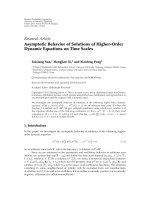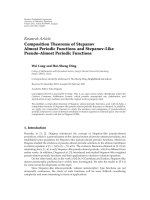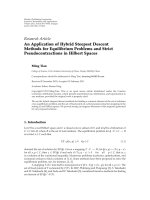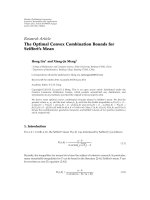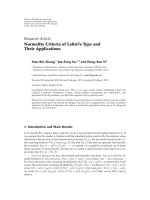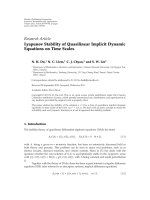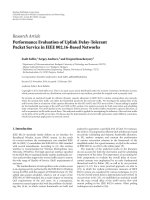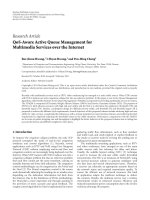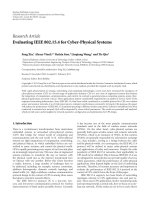báo cáo hóa học:" Research Article Asymptotic Behavior of Equilibrium Point for a Family of Rational Difference Equations" docx
Bạn đang xem bản rút gọn của tài liệu. Xem và tải ngay bản đầy đủ của tài liệu tại đây (562.87 KB, 10 trang )
Hindawi Publishing Corporation
Advances in Difference Equations
Volume 2010, Article ID 505906, 10 pages
doi:10.1155/2010/505906
Research Article
Asymptotic Behavior of Equilibrium Point for
a Family of Rational Difference Equations
Chang-you Wang,
1, 2, 3
Qi-hong Shi,
4
and Shu Wang
3
1
College of Mathematics and Physics, Chongqing University of Posts and Telecommunications,
Chongqing 400065, China
2
Key Laboratory of Network Control and Intelligent Instrument, Chongqing University of
Posts and Telecommunications, Ministry of Education, Chongqing 400065, China
3
College of Applied Sciences, Beijing University of Technology, Beijing 100124, China
4
Fundamental Department, Hebei College of Finance, Baoding 071051, China
Correspondence should be addressed to Chang-you Wang,
Received 7 August 2010; Accepted 19 October 2010
Academic Editor: Rigoberto Medina
Copyright q 2010 Chang-you Wang et al. This is an open access article distributed under the
Creative Commons Attribution License, which permits unrestricted use, distribution, and
reproduction in any medium, provided the original work is properly cited.
This paper is concerned with the following nonlinear difference equation x
n1
l
i1
A
s
i
x
n−s
i
/B
C
k
j1
x
n−t
j
Dx
n
,n 0, 1, , where the initial data x
−m
,x
−m1
, ,x
−1
,x
0
∈ R
, m
max{s
1
, ,s
l
,t
1
, ,t
k
}, s
1
, ,s
l
,t
1
, ,t
k
are nonnegative integers, and A
s
i
, B, C,andD are
arbitrary positive real numbers. We give sufficient conditions under which the unique equilibrium
x 0 of this equation is globally asymptotically stable, which extends and includes corresponding
results obtained in the work of C¸inar 2004,Yangetal.2005, and Berenhaut et al. 2007.In
addition, some numerical simulations are also shown to support our analytic results.
1. Introduction
Difference equations appear naturally as discrete analogues and in the numerical solutions of
differential and delay differential equations, and they have applications in biology, ecology,
physics, and so forth 1. The study of properties of nonlinear difference equations has been
an area of intense interest in recent years. There has been a lot of work concerning the
globally asymptotic behavior of solutions of rational difference equations e.g., see 2–5.
In particular, C¸inar6 studied the properties of positive solution to
x
n1
x
n−1
1 x
n
x
n−1
,n 0, 1, 1.1
2 Advances in Difference Equations
Yang et al. 7 investigated the qualitative behavior of the recursive sequence
x
n1
ax
n−1
bx
n−2
c dx
n−1
x
n−2
,n 0, 1, 1.2
More recently, Berenhaut et al. 8 generalized the result reported in 7 to
x
n
y
n−k
y
n−m
1 y
n−k
y
n−m
,n 0, 1, 1.3
For more similar work, one can refer to 9–14 and references therein.
The main theorem in this paper is motivated by the above studies. The essential
problem we consider in this paper is the asymptotic behavior of the solutions for
x
n1
l
i1
A
s
i
x
n−s
i
B C
k
j1
x
n−t
j
Dx
n
,n 0, 1, , 1.4
with initial data x
−m
,x
−m1
, ,x
−1
,x
0
∈ R
,m max{s
1
, ,s
l
,t
1
, ,t
k
},s
1
, ,s
l
,t
1
, ,t
k
are nonnegative integers, and A
s
i
,B,C,and D are arbitrary positive real numbers. In addition,
some numerical simulations of the behavior are shown to illustrate our analytic results.
This paper proceeds as follows. In Section 2, we introduce some definitions and
preliminary results. The main results and their proofs are given in Section 3. Finally, some
numerical simulations are shown to support theoretical analysis.
2. Preliminaries and Notations
In this section, we prepare some materials used throughout this paper, namely, nota-
tions, the basic definitions, and preliminary results. We refer to the monographs of
Koci
´
c and Ladas 2, and Kulenovi
´
c and Ladas 3.
Let σ and κ be two nonnegative integers such that σ κ n. We usually write a vector
x x
1
,x
2
, ,x
n
with n components into x x
σ
, x
κ
, where x
σ
denotes a vector with
σ-components of x.
Lemma 2.1. Let I be some interval of real numbers and
f : I
k1
−→ I 2.1
be a continuously differentiable function. Then, for every set of initial conditions x
−k
,x
−k1
, ,x
0
∈
I,
x
n1
f
x
n
,x
n−1
, ,x
n−k
,n 0, 1, 2.2
has a unique solution {x
n
}
∞
n−k
.
Advances in Difference Equations 3
Definition 2.2. Function f : R
m
→ R is called mixed monotone in subset I
m
of R
m
if fx
σ
, x
κ
is monotone nondecreasing in each component of x
σ
and is monotone
nonincreasing in every component of x
κ
for x ∈ I
m
.
Definition 2.3. If there exists a point
x ∈ I such that x fx, x, ,x, x, x is called an
equilibrium point of 2.2.
Definition 2.4. Let
x be an equilibrium point of 2.2.
1 The equilibrium
x of 2.2 is locally stable if for every ε>0, there exists δ>0
such that for any initial data x
−m
,x
−m1
, ,x
−1
,x
0
∈ I
m1
satisfying max{|x
−m
−
x|, |x
−m1
− x|, ,|x
0
− x|} <δ,|x
n
− x| <εholds for all n ≥−m.
2 The equilibrium
x of 2.2 is a local attractor if there exists δ>0 such that
lim
n →∞
x
n
x for any data x
−m
,x
−m1
, ,x
−1
,x
0
∈ I
m1
satisfying max{|x
−m
−
x|, |x
−m1
− x|, ,|x
0
− x|} <δ.
3 The equilibrium
x of 2.2 is locally asymptotically stable if it is stable and is a local
attractor.
4 The equilibrium
x of 2.2 is a global attractor if for all x
−m
,x
−m1
, ,x
−1
,x
0
∈ I,
lim
n →∞
x
n
x holds.
5
x is globally asymptotically stable if it is stable and is a global attractor.
6
x is unstable if it is not locally stable.
Lemma 2.5. Assume that s
1
,s
2
, ,s
k
∈ R and k ∈ N. Then,
|
s
1
|
|
s
2
|
···
|
s
k
|
< 1 2.3
is a sufficient condition for the local stability of the difference equation
x
nk
s
1
x
nk−1
··· s
k
x
n
0,n 0, 1, 2.4
3. The Main Results and Their Proofs
In this section, we investigate the globally asymptotic stability of the equilibrium point of
1.4.
It is obvious that
x 0 is a unique equilibrium point of 1.4 provided either 0 <D<
1,
l
i1
A
s
i
<B1 −D or D ≥ 1.
Let f : R
m
→ R
be a multivariate continuous function defined by
f
x
n−s
1
, ,x
n−s
l
,x
n−t
1
, ,x
n−t
k
,x
n
l
i1
A
s
i
x
n−s
i
B C
k
j1
x
n−t
j
Dx
n
. 3.1
4 Advances in Difference Equations
If s
1
/
···
/
s
l
/
t
1
/
···
/
t
k
, we have
f
x
n−s
i
x
n−s
1
, ,x
n−s
l
,x
n−t
1
, ,x
n−t
k
,x
n
A
s
i
B C
k
j1
x
n−t
j
,s
i
/
0,i 1, 2, ,l,
f
x
n−s
i
x
n−s
1
, ,x
n−s
l
,x
n−t
1
, ,x
n−t
k
,x
n
A
s
i
B C
k
j1
x
n−t
j
D, for some s
i
0,
i ∈
{
1, 2, ,l
}
,
f
x
n−t
j
x
n−s
1
, ,x
n−s
l
,x
n−t
1
, ,x
n−t
k
,x
n
−C
l
i1
A
s
i
x
n−s
i
B C
k
r1
x
n−t
r
2
k
r1,r
/
j
x
n−t
r
,
t
j
/
0,j 1, 2, ,k,
f
x
n−t
j
x
n−s
1
, , x
n−s
l
,x
n−t
1
, , x
n−t
k
,x
n
−C
l
i1
A
s
i
x
n−s
i
B C
k
r1
x
n−t
r
2
k
r1,r
/
j
x
n−t
r
D,
for some t
j
0,j∈
{
1, 2, ,k
}
,
f
x
n
x
n−s
1
, ,x
n−s
l
,x
n−t
1
, ,x
n−t
k
,x
n
D, s
i
,t
j
/
0,i 1, 2, ,l, j 1, 2, k.
3.2
By constructing 1.4 and applying Lemma 2.5, we have the following affirmation.
Theorem 3.1. If s
1
/
···
/
s
l
/
t
1
/
···
/
t
k
, and
l
i1
A
s
i
<B1 − D with 0 <D<1, then the
unique equilibrium point
x 0 of 1.4 is locally stable. If D ≥ 1, x 0 is unstable.
Proof. Considering the linearized equation of 1.4 with respect to equilibrium point
x 0,
z
n1
Dz
n
l
i1
A
s
i
z
n−s
i
B
0, for s
i
/
0,i 1, 2, ,l,
z
n1
Dz
n
l
i1
A
s
i
z
n−s
i
B
0, for some t
j
0,j∈
{
1, 2, ,k
}
,
z
n1
Dz
n
l
i1
A
s
i
z
n−s
i
B
0, for s
i
,t
j
/
0,i 1, 2, ,l, j 1, 2, k,
z
n1
D
A
s
p
B
z
n
l
i1,i
/
p
A
s
i
z
n−s
i
B
0, for some s
p
0,p∈
{
1, 2, ,l
}
.
3.3
By Lemma 2.5, 1.4 is stable if the following inequality holds
D
l
i1
A
s
i
B
< 1, 3.4
which implies our claim.
Advances in Difference Equations 5
When D ≥ 1, note that the solution of 1.4 is x
n
> 0, hence x
n1
≥ Dx
n
≥ x
n
, which
implies that {x
n
}
∞
n1
is a dispersed sequence.
Theorem 3.2. Let f : R
m1
→ R defined by 2.2 be a continuous function satisfying the mixed
monotone property. If there exists two real numbers Ω
0
, Θ
0
satisfying
Ω
0
≤ min
{
x
−m
,x
−m1
, ,x
−1
,x
0
}
≤ max
{
x
−m
,x
−m1
, ,x
−1
,x
0
}
≤ Θ
0
, 3.5
such that
Ω
0
≤ f
Ω
0
σ
,
Θ
0
κ
≤ f
Θ
0
σ
,
Ω
0
κ
≤ Θ
0
, 3.6
then there exists Ω, Θ ∈ Ω
0
, Θ
0
2
satisfying
Ωf
Ω
σ
,
Θ
κ
, Θf
Θ
σ
,
Ω
κ
. 3.7
Moreover, if ΩΘ,then2.2 has a unique equilibrium point
x ∈ Ω
0
, Θ
0
, and every solution of
2.2 converges to
x.
Proof. Let Ω
0
and Θ
0
be a couple of initial iteration data, then we construct two sequences
{Ω
i
}
∞
i1
and {Θ
i
}
∞
i1
in the form
Ω
i
f
Ω
i−1
σ
,
Θ
i−1
κ
, Θ
i
f
Θ
i−1
σ
,
Ω
i−1
κ
. 3.8
Note that mixed monotone property of f and initial assumption, the sequences {Ω
i
}
∞
i1
and
{Θ
i
}
∞
i1
thus possess
Ω
0
≤ Ω
1
≤···≤Ω
i
≤ Θ
i
≤···≤Θ
1
≤ Θ
0
,i 0, 1, 2, 3.9
It guarantees one can choose a new sequence {x
l
}
∞
l1
satisfying Ω
i
≤ x
l
≤ Θ
i
for l ≥ m1i1.
Denote
Ω lim
i →∞
Ω
i
, Θ lim
i →∞
Θ
i
, 3.10
then
Ω ≤ lim
i →∞
inf x
i
≤ lim
i →∞
sup x
i
≤ Θ. 3.11
By the continuity of f, we have
Ωf
Ω
σ
,
Θ
κ
, Θf
Θ
σ
,
Ω
κ
. 3.12
Moreover, if ΩΘ, then ΩΘlim
i →∞
x
i
x, and then the proof is complete.
6 Advances in Difference Equations
Theorem 3.3. If 0 <D<1,
l
i1
A
s
i
<B
2
1 − D/k 1C B, and t
j
/
0j 1, 2, ,k,
then the unique equilibrium point
x 0 of 1.4 is global attractor for any initial conditions
x
−m
,x
−m1
, ,x
1
,x
0
∈ 0, 1
m1
.
Proof. For any nonnegative initial data x
−i
,i ∈{0, 1, 2, ,m}, it is obvious that the function
fx
n−s
1
, ,x
n−s
l
,x
n−t
1
, ,x
n−t
k
,x
n
defined by 3.1 is nondecreasing in x
n−s
1
, ,x
n−s
l
,x
n
and nonincreasing in x
n−t
1
, ,x
n−t
k
.
Let
Ω
0
0, Θ
0
max
{
x
−m
, ,x
−1
,x
0
}
, 3.13
by view of the assumption
l
i1
A
s
i
<B
2
1 − D/k 1C B, we have
Ω
0
≤ f
Ω
0
σ
,
Θ
0
k
l
i1
A
s
i
Ω
0
B C
Θ
0
k
DΩ
0
≤ f
Θ
0
σ
,
Ω
0
κ
l
i1
A
s
i
Θ
0
B C
Ω
0
k
DΘ
0
≤
Θ
0
l
i1
A
s
i
B
DΘ
0
≤
Θ
0
k 1
C B
l
i1
A
s
i
B
2
DΘ
0
≤ Θ
0
.
3.14
From 1.4 and Theorem 3.2, there exists Ω, Θ ∈ Ω
0
, Θ
0
2
satisfying
Ω
l
i1
A
s
i
Ω
B CΘ
k
DΩ, Θ
l
i1
A
s
i
Θ
B CΩ
k
DΘ. 3.15
Taking the difference
Ω − Θ
l
i1
A
s
i
Ω
B CΘ
k
−
l
i1
A
s
i
Θ
B CΩ
k
D
Ω − Θ
, 3.16
we deduce that
1 − D
Ω − Θ
−
l
i1
A
s
i
Ω
B CΩ
k
−
l
i1
A
s
i
Θ
B CΘ
k
B CΘ
k
B CΩ
k
0, 3.17
which implies
⎡
⎣
1 − D
−
l
i1
A
s
i
B C
l
i1
A
s
i
pqk
Ω
p
Θ
q
B CΘ
k
B CΩ
k
⎤
⎦
Ω − Θ
0, 3.18
where
pqk
Ω
p
Θ
q
Ω
k
Ω
k−1
Θ···ΩΘ
k−1
Θ
k
.
Advances in Difference Equations 7
By view of 0 <D<1,
l
i1
A
s
i
<B
2
1 − D/k 1C B and initial conditions
x
−m
,x
−m1
, ,x
1
,x
0
∈ 0, 1
m1
, therefore we have
1 − D
−
l
i1
A
s
i
B C
l
i1
A
s
i
pqk
Ω
p
Θ
q
B CΘ
k
B CΩ
k
>
1 − D
−
B C
k 1
l
i1
A
s
i
B
2
> 0,
3.19
thus, we have
ΩΘ. 3.20
By Theorem 3.2, then every solution of 1.4 converges to the unique equilibrium point
x
0.
Theorem 3.4. If 0 <D<1,
l
i1
A
s
i
<B
2
1 −D/k 1C B,s
1
/
···
/
s
l
/
t
1
/
···
/
t
k
, and
t
j
/
0j ∈{1, 2, ,k}, then the unique equilibrium point
x 0 of 1.4 is globally asymptotically
stable for any initial conditions x
−m
,x
−m1
, ,x
1
,x
0
∈ 0, 1
m1
.
Proof. The result holds from Theorems 3.1 and 3.3.
Theorem 3.5. If 0 <D<1,
l
i1
A
s
i
<B
2
1 −D/k 1μ
k
C B, and t
j
/
0j ∈{1, 2, ,k},
then the unique equilibrium point
x 0 of 1.4 is global attractor for any initial conditions
x
−m
,x
−m1
, ,x
1
,x
0
∈ 0,μ
m1
.
Proof. The proof of this Theorem is similar to that of Theorem 3.3. We omit the details.
Theorem 3.6. If 0 <D<1,
l
i1
A
s
i
<B
2
1−D/k 1μ
k
CB,s
1
/
···
/
s
l
/
t
1
/
···
/
t
k
, and
t
j
/
0j ∈{1, 2, ,k}, then the unique equilibrium point
x 0 of 1.4 is globally asymptotically
stable for any initial conditions x
−m
,x
−m1
, ,x
1
,x
0
∈ 0,μ
m1
.
Proof. The result holds from Theorems 3.1 and 3.5.
4. Numerical Simulation
In this section, we give some numerical simulations supporting our theoretical analysis via
the software package Matlab 7.1. As examples, we consider
x
n1
0.05x
n−2
0.02x
n−4
0.03x
n
8 x
n−1
x
n−3
1
2
x
n
, 4.1
x
n1
0.3x
n−4
0.2x
n−3
10 3x
n−1
x
n−2
1
2
x
n
, 4.2
x
n1
x
n−4
x
n−3
8 3x
n−1
x
n−2
2x
n
.
4.3
8 Advances in Difference Equations
0
0.5
1
1.5
y
2
2.5
3
3.5
4
−100 102030405060
n
y xn
Figure 1
0
0.5
1
1.5
y
2
2.5
3
−100 102030405060
n
y xn
Figure 2
Let μ 4, it is obvious that 4.1 and 4.2 satisfy the conditions of Theorem 3.6 when
the initial datas x
−4
,x
−3
,x
−2
,x
−1
,x
0
∈ 0, 4
5
. Equation 4.3 satisfies the conditions of
Theorem 3.1 for the initial data x
−4
,x
−3
,x
−2
,x
−1
,x
0
∈ R
.
By employing the software package Matlab 7.1, we can solve the numerical solutions
of 4.1, 4.2,and4.3 which are shown, respectively, in Figures 1, 2,and3. More precisely,
Figure 1 shows the asymptotic behavior of the solution to 4.1 with initial data x
−4
2,x
−3
0.2,x
−2
1.1,x
−1
3.7, and x
0
0.5, Figure 2 shows the asymptotic behavior of the solution
to 4.2 with initial data x
−4
1,x
−3
2.2,x
−2
2,x
−1
2.7, and x
0
0.5, and Figure 3
shows the asymptotic behavior of the solution to 4.3 with initial data x
−4
0.1,x
−3
2.7,x
−2
1.1,x
−1
3.7, and x
0
0.5.
Advances in Difference Equations 9
0
0.5
1
1.5
y
2
2.5
×10
4
−4 −2 0 2 4 6 8 10 12 14 16
n
y xn
Figure 3
5. Conclusions
This paper presents the use of a variational iteration method for systems of nonlinear
difference equations. This technique is a powerful tool for solving various difference
equations and can also be applied to other nonlinear differential equations in mathematical
physics. The numerical simulations show that this method is an effective and convenient
one. The variational iteration method provides an efficient method to handle the nonlinear
structure. Computations are performed using the software package Matlab 7.1.
We have dealt with the problem of global asymptotic stability analysis for a class of
nonlinear difference equation. The general sufficient conditions have been obtained to ensure
the existence, uniqueness, and global asymptotic stability of the equilibrium point for the
nonlinear difference equation. These criteria generalize and improve some known results.
In particular, some examples are given to show the effectiveness of the obtained results. In
addition, the sufficient conditions that we obtained are very simple, which provide flexibility
for the application and analysis of nonlinear difference equation.
Acknowledgments
The authors are grateful to the referee for giving us lots of precious comments. This work is
supported by Natural Science Foundation Project of CQ CSTC Grant no. 2008BB 7415 of
China, and National Science Foundation Grant no. 40801214 of China.
References
1 W T. Li and H R. Sun, “Global attractivity in a rational recursive sequence,” Dynamic Systems and
Applications, vol. 11, no. 3, pp. 339–345, 2002.
2 V. L . K oc i
´
c and G. Ladas, Global Behavior of Nonlinear Difference Equations of Higher Order with
Applications, vol. 256 of Mathematics and Its Applications, Kluwer Academic Publishers, Dordrecht, The
Netherlands, 1993.
10 Advances in Difference Equations
3 M. R. S. Kulenovi
´
c and G. Ladas, Dynamics of Second Order Rational Difference Equations with Open
Problems and Conjectures, Chapman & Hall/CRC, Boca Raton, Fla, USA, 2002.
4 H. M. El-Owaidy, A. M. Ahmed, and M. S. Mousa, “On the recursive sequences x
n1
−αx
n−1
/β ±
x
n
,” Applied Mathematics and Computation, vol. 145, no. 2-3, pp. 747–753, 2003.
5 X Y. Xianyi and D M. Zhu, “Global asymptotic stability in a rational equation,” Journal of Difference
Equations and Applications, vol. 9, no. 9, pp. 833–839, 2003.
6 C. C¸ inar, “On the positive solutions of the difference equation x
n1
x
n−1
/1 x
n
x
n−1
,” Applied
Mathematics and Computation, vol. 150, no. 1, pp. 21–24, 2004.
7 X. Yang, W. Su, B. Chen, G. M. Megson, and D. J. Evans, “On the recursive sequence x
n
ax
n−1
bx
n−2
/c dx
n−1
x
n−2
,” Applied Mathematics and Computation, vol. 162, no. 3, pp. 1485–1497, 2005.
8 K.S.Berenhaut,J.D.Foley,andS.Stevi
´
c, “The global attractivity of the rational difference equation
y
n
y
n−k
y
n−m
/1 y
n−k
y
n−m
,” Applied Mathematics Letters, vol. 20, no. 1, pp. 54–58, 2007.
9 K. S. Berenhaut and S. Stevi
´
c, “The difference equation x
n1
a x
n−k
/
k−1
i0
c
i
x
n−i
has solutions
converging to zero,” Journal of Mathematical Analysis and Applications, vol. 326, no. 2, pp. 1466–1471,
2007.
10 R. Memarbashi, “Sufficient conditions for the exponential stability of nonautonomous difference
equations,” Applied Mathematics Letters, vol. 21, no. 3, pp. 232–235, 2008.
11 M. Aloqeili, “Global stability of a rational symmetric difference equation,” Applied Mathematics and
Computation, vol. 215, no. 3, pp. 950–953, 2009.
12 M. Aprahamian, D. Souroujon, and S. Tersian, “Decreasing and fast solutions for a second-order
difference equation related to Fisher-Kolmogorov’s equation,” Journal of Mathematical Analysis and
Applications, vol. 363, no. 1, pp. 97–110, 2010.
13 C y. Wang, F. Gong, S. Wang, L r. Li, and Q h. Shi, “Asymptotic behavior of equilibrium point for a
class of nonlinear difference equation,” Advances in Difference Equations, vol. 2009, Article ID 214309,
8 pages, 2009.
14 C y. Wang, S. Wang, Z w. Wang, F. Gong, and R f. Wang, “Asymptotic stability for a class of
nonlinear difference equations,” Discrete Dynamics in Nature and Society, vol. 2010, Article ID 791610,
10 pages, 2010.
